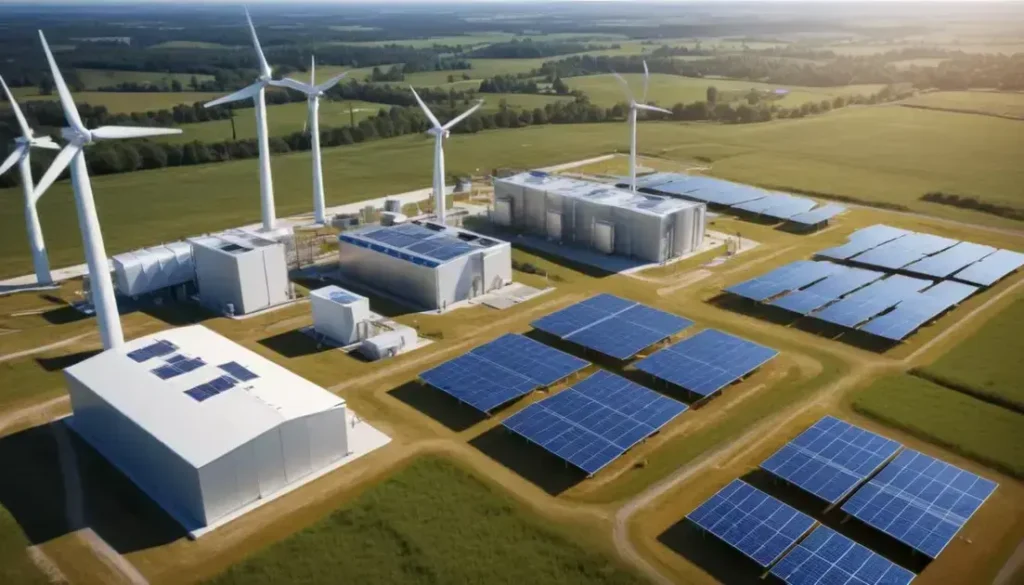A flow state is a mental condition that enhances focus and creativity, allowing individuals to work optimally and efficiently, which can lead to improved productivity and job satisfaction in workplace environments.
Have you ever experienced flow state? This mental state of deep focus and engagement can significantly transform productivity in businesses. Let’s explore how harnessing this state can foster creativity and growth in UK firms.
Understanding Flow State
The flow state is a mental condition where individuals become fully immersed in a task, often losing track of time and surroundings. This state is crucial for enhancing creativity and boosting productivity in the workplace. Achieving flow involves a delicate balance between challenge and skill, allowing employees to engage deeply with their work.
To foster a flow state, organisations must create an environment that promotes focus. Minimising distractions is vital; workplaces should be designed to reduce noise and interruptions, enabling employees to concentrate on their tasks. Tools such as time management techniques can further support this focus.
Incorporating regular breaks can also enhance productivity, allowing employees to recharge mentally and return to their tasks with renewed vigor. Moreover, training sessions can teach staff how to recognise and achieve their own flow state, equipping them with the skills needed to enhance their work performance.
Understanding the dynamics of the flow state not only benefits individual workers but also contributes to overall team performance. As employees engage more deeply, their collaboration improves, leading to innovative solutions and a more dynamic working environment.
Benefits of Flow State in Workplaces
The benefits of flow state in workplaces are profound, impacting both individual performance and overall organisational success. When employees enter this state, they often achieve higher levels of productivity. This heightened focus allows them to complete tasks more efficiently and with greater accuracy.
Moreover, flow state is closely associated with increased creativity. As individuals immerse themselves in their work, they are more likely to experiment with new ideas and approaches. This innovation can lead to unique solutions that benefit the business as a whole.
Another significant advantage is enhanced job satisfaction. Employees who regularly experience flow find their work more fulfilling, which can reduce turnover rates and improve morale. A positive work environment that encourages flow can lead to stronger teams and a cohesive company culture.
To cultivate flow, organisations should implement strategies that align employee strengths with job demands. Providing the right balance of challenge and skill is crucial for fostering this state. Additionally, offering resources such as training and development can support employees in their pursuit of flow, making work not only productive but also enjoyable.
Creating a Flow State Environment
Creating a flow state environment is essential for maximising productivity and creativity in the workplace. This involves designing spaces that facilitate focus and engagement. Key elements include comfortable seating, adequate lighting, and minimal distractions. A well-structured layout encourages movement while promoting concentration.
Additionally, incorporating nature into the workspace can significantly enhance the atmosphere. Elements like plants, natural light, and soothing colours contribute to a calming environment. Such features have been proven to reduce stress and improve overall well-being, which is vital for achieving flow.
Another aspect to consider is the need for flexible workspaces. Allowing employees to choose where they work best fosters a sense of control and comfort. Some may prefer collaborative areas for brainstorming, while others might seek quiet corners for deep work. Providing a variety of spaces caters to diverse working styles and enhances the opportunity to enter flow.
Furthermore, implementing sound management techniques is crucial. Consider using sound-absorbing materials or creating quiet zones to minimise auditory distractions. This ensures that employees can immerse themselves in their tasks without interruptions, ultimately setting the stage for a productive flow state.
Techniques to Achieve Flow
Employing specific techniques to achieve flow can significantly enhance productivity and creativity in any work environment. One effective method is to set clear goals. When employees know what they aim to accomplish, they can concentrate better and direct their energy towards achieving these objectives.
Another technique is to reduce or eliminate distractions. Creating a dedicated workspace free from interruptions can help individuals maintain focus and enter a flow state more easily. This may include using noise-cancelling headphones or selecting quieter times to work on complex tasks.
Incorporating regular breaks is also crucial for fostering flow. Taking short pauses allows the brain to recharge, preventing fatigue and maintaining high levels of engagement. Techniques such as the Pomodoro Technique encourage individuals to work in focused bursts followed by brief breaks, which can enhance concentration over time.
Mindfulness practices, such as meditation or deep breathing exercises, can also prepare the mind for flow. These activities help calm distractions and improve mental clarity, paving the way for deeper focus. Additionally, individuals should strive to find the right balance between challenge and skill, ensuring tasks are engaging yet not overwhelming.
Case Studies on Flow State
Examining case studies on flow state provides valuable insights into its practical applications and benefits in various industries. Notable examples illustrate how organisations leverage flow to enhance employee performance and creativity. In the technology sector, for instance, companies often report increased innovation when teams work in a flow state, resulting in successful product launches.
One notable case is that of a leading software development company that implemented strategies to foster flow among its teams. By promoting flexible work hours and creating a distraction-free environment, they saw a significant boost in coding efficiency and teamwork. This adjustment led not only to faster project completions but also to a rise in employee satisfaction and retention.
Similarly, in the creative field, advertising agencies have shared experiences in which flow state impacted the quality of their campaigns. By encouraging a culture that values uninterrupted time for brainstorming, these agencies noticed an uptick in innovative ideas and overall campaign effectiveness.
Research in sports also reinforces the importance of flow. Athletes often achieve peak performance when in this state, as it allows them to execute complex movements instinctively. This understanding is being adapted in corporate training programs aimed at enhancing performance through flow-focused techniques.
Impact of Flow on Creativity
The impact of flow on creativity is significant and well-documented in various fields. When individuals enter a flow state, their minds become deeply immersed in the task at hand, enabling them to think outside the box and generate innovative ideas. This heightened state of focus reduces distractions, allowing for a seamless flow of thoughts and inspiration.
Research indicates that creative professionals, such as writers and artists, often achieve their best work when in flow. In this state, they experience a sense of joy and fulfilment, which further enhances their creative output. The absence of self-criticism during flow allows for freer expression, leading to more original and impactful creations.
Additionally, flow facilitates risk-taking, which is essential for creativity. Individuals are more willing to explore uncharted territories and experiment with new concepts. This willingness to take risks can lead to groundbreaking ideas that might not emerge under conventional working conditions.
Moreover, collaborative environments that encourage flow can amplify creative potential across teams. When group members experience flow together, they can share ideas more dynamically, resulting in unexpected and impressive solutions. Integrating practices that promote flow in both individual and team settings is crucial for cultivating creativity in any organisation.
Long-term Benefits for Businesses
The long-term benefits for businesses that cultivate a flow state among their employees are substantial. Firstly, organisations often witness a marked increase in overall productivity. When employees frequently operate in a flow state, they complete tasks more efficiently and with higher accuracy, contributing to better operational outcomes.
Moreover, fostering flow enhances employee engagement. Workers who can achieve this state regularly report higher job satisfaction and motivation. This is crucial for reducing turnover rates, as engaged employees are more likely to remain with their companies, thus saving on recruitment and training costs.
Additionally, businesses that prioritise flow can benefit from increased innovation. A culture that encourages employees to dive deep into their tasks promotes creativity, leading to new ideas and improved products or services. As a result, continuous innovation can position a company as a leader in its industry.
In the long run, a strong focus on flow creates a positive company culture. Employees feel valued and understood when their needs for an optimal working environment are met. This not only boosts morale but also enhances collaboration across teams. Ultimately, these long-term benefits contribute to a sustainable competitive advantage in the marketplace.
Practical Applications for UK Firms
The practical applications for UK firms focusing on flow state can transform workplace dynamics significantly. By implementing strategies that promote flow, businesses can enhance productivity and employee satisfaction. One effective approach is establishing flexible work environments that allow employees to choose their work settings, whether that’s a quiet room or a collaborative space.
Additionally, UK firms can benefit from adopting time management techniques that encourage uninterrupted periods of deep work. This might involve implementing systems such as the Pomodoro Technique, which encourages short bursts of intense focus followed by brief breaks, allowing employees to recharge while maintaining productivity.
Training programs that teach mindfulness and focus techniques can further help employees harness flow. Workshops on mindfulness practices can equip staff with tools to reduce distractions and enhance their concentration. This is critical in high-stakes environments where creativity and quick decision-making are essential.
Moreover, gathering feedback from employees about their experiences with flow can provide valuable insights for continuous improvement. Encouraging open dialogues about work processes helps firms adapt their practices to optimise conditions for achieving flow. Overall, prioritising flow state not only leads to improved company performance but also fosters a culture of innovation and engagement.
In Summary: Harnessing the Power of Flow State
Understanding and implementing the flow state in the workplace can lead to significant benefits for UK firms. By creating environments that foster focus and creativity, businesses can enhance productivity and job satisfaction.
Strategies such as flexible workspaces, effective time management techniques, and mindfulness practices empower employees to achieve their best work. As firms prioritise flow, they not only improve individual performance but also cultivate a culture of innovation.
Therefore, as you take steps to embed flow into your organisation, you position your business for long-term success and resilience in a competitive market.
Frequently Asked Questions
What is flow state and why is it important?
Flow state is a mental condition where individuals are fully immersed in an activity, leading to increased focus and productivity. It’s important because it enhances creativity and job satisfaction.
How can UK firms create an environment that promotes flow?
Firms can create a flow-promoting environment by offering flexible workspaces, minimising distractions, and implementing time management techniques like the Pomodoro Technique.
What are some techniques to help employees achieve flow?
Techniques include setting clear goals, reducing interruptions, taking regular breaks, and incorporating mindfulness practices to enhance focus.
How does flow state impact employee engagement?
When employees achieve flow state frequently, they tend to be more engaged and satisfied with their work, which reduces turnover rates and enhances overall morale.
What long-term benefits can businesses expect from fostering flow?
Long-term benefits include improved productivity, increased innovation, better employee retention, and a positive company culture.
How can I measure if employees are experiencing flow?
Employers can gather feedback through surveys, observe performance metrics, and track employee engagement levels to assess the presence of flow in the workplace.


